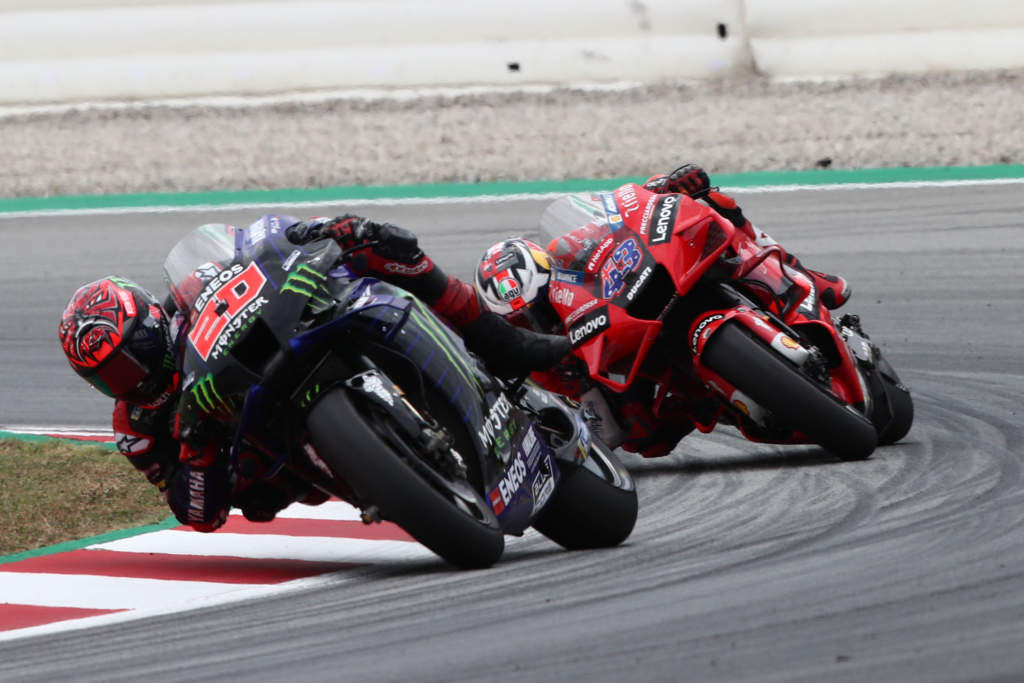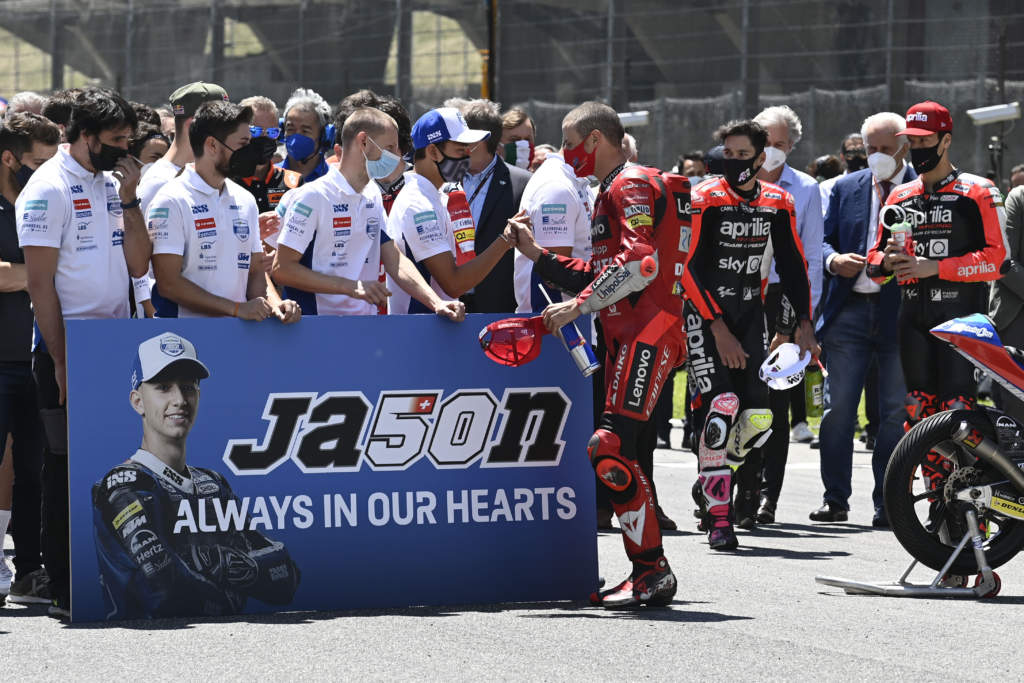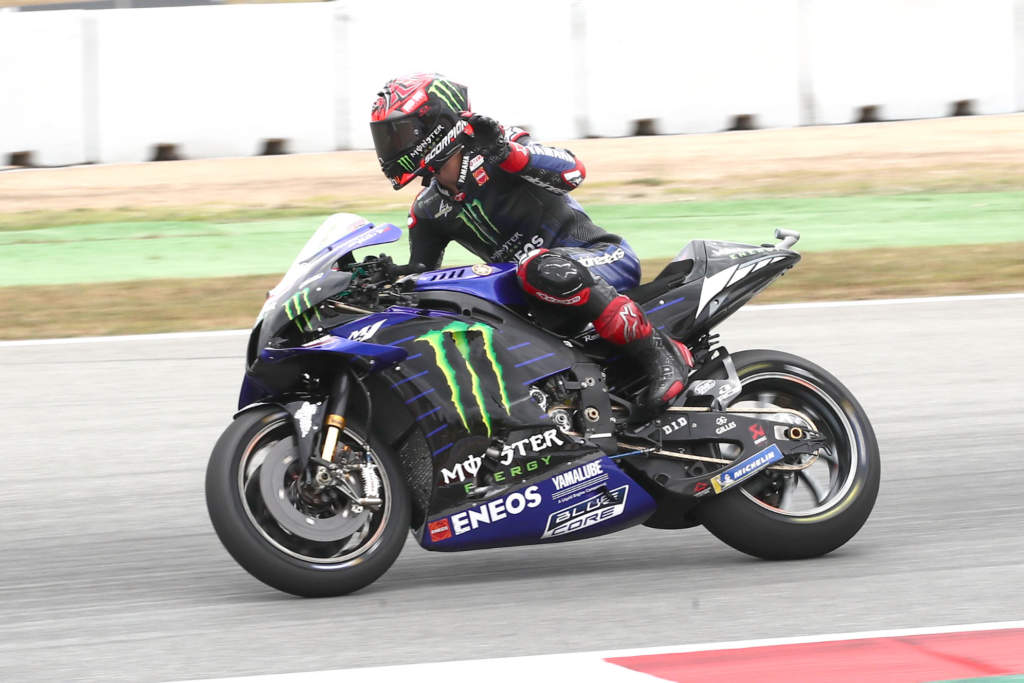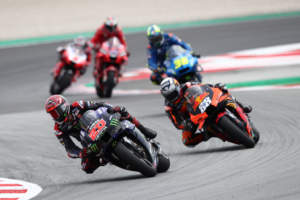MotoGP championship leader Fabio Quartararo was penalised for finishing the Catalan Grand Prix with his chest exposed after his leathers came undone, but – argues Simon Patterson in this opinion column – that was the wrong ruling, issued way too late. And it’s raised the biggest question marks over MotoGP stewarding yet, Simon argues.
When three-time world champion Freddie Spencer was appointed to lead an all-new MotoGP stewards panel at the start of the 2019 season, it was heralded as a much-needed change for the sport.
After a few decisions in previous seasons that were rated as poor, it was hoped that the American and his new permanent second-in-command, former airline pilot Bill Cumbow, would bring a new air of fairness to the policing.
Since then, unfortunately, it’s gone the other way, with a series of controversial penalties – and a perception in the paddock that other incidents that contravened rules are going unpunished.
Already an issue in previous seasons, it’s something that’s built to a head in 2021. It started at the very first race with Jack Miller escaping penalty for what champion Joan Mir believes was a deliberate attempt to run him off the track in Qatar, but since then we’ve seen MotoGP riders escaping penalties for touring on track and Moto3 riders risking huge collisions by rolling off the throttle mid-corner – all with little to no apparent investigation never mind repercussions.
It’s slowly but surely weakening the officials’ position within the paddock and damaging their credibility.
What they did to Fabio Quartararo at the Catalan Grand Prix – and why they did it – is perhaps the most egregious enforcement of the rules we’ve seen from MotoGP officials to date, and if it doesn’t bring about serious conversations within the sport then something is terribly wrong.

It all started in the closing laps of Sunday’s race at Barcelona, when Quartararo suddenly went from challenging for the lead to barely holding onto the fight for the podium. It was immediately clear that something had gone wrong, even though it wasn’t immediately clear what it was. Only later in the race did it become obvious that somehow his leathers had opened, leaving Quartararo dangerously exposed for the last five laps.
It’s pretty obvious what should have immediately happened. Had Quartararo crashed out with nothing at all protecting his exposed chest, the consequences would have been serious, potentially even fatal.
Looking back at my Twitter timeline, I posted within a minute saying that Quartararo needed to be black flagged for his own safety. I wasn’t the only one, with a whole host of others in the sport joining in immediately. Even the notoriously shy Casey Stoner, a man who rarely takes to social media, tweeted to say that Quartararo needed to be stopped.
Instead, we watched, in absolute shock as he was allowed to ride around for something like another 11 minutes, finishing the final quarter of the race with no action taken. It’s hardly like it wasn’t obvious, either – his Yamaha had a rider-facing onboard camera looking directly at him and hinting every time TV directors cut to it what could occur should he make the smallest error.
Extraordinary scenes in the closing stages involving @FabioQ20! 👀
For riding without his chest protector and his leather suit correctly fastened, the Frenchman received a 3-second penalty#CatalanGP 🏁 pic.twitter.com/9EBy6hVSjN
— MotoGP™🏁 (@MotoGP) June 6, 2021
All this in the current mood the MotoGP paddock finds itself in. It’s only a week since the tragic death of 19-year-old Moto3 rider Jason Dupasquier at the Italian Grand Prix, and rider safety and welfare is still an extremely raw subject in the paddock.

Which is why it absolutely beggars belief that the stewards panel response to what happened to Quartararo wasn’t to black flag him during the race, stopping him for his own safety – but to throw the rulebook at him after the event.
Look, no one wanted to see Quartararo disqualified for what he did. Clearly, something went wrong with his equipment, and the simple fact of the matter is, he didn’t do anything deliberate to gain an advantage.
He tried to fix an issue and in the process he made it worse, sure – but it’s not like he purposely rolled down pitlane without wearing the chest protector he disposed of on track after it started causing him problems.
So when it was announced after the race that he was being sanctioned with what amounted to a two-place demotion for breaking 2.4.5.2 of the MotoGP regulations (which states that that safety equipment “must be worn, correctly fastened, at all times during on-track activity”), it was hard not to be sceptical about the justification.
Quartararo needed to be removed from Sunday’s race, sure – but he should have been removed at the time, to protect himself from injury. He shouldn’t have been demoted by some invented amount of time after the occasion simply because race control hadn’t dealt with it earlier in the day.
Had they taken the decision out of his hands immediately instead of letting him ride around tempting fate, then there would have been no need to invent an ambiguous three-second sentence that demoted him two places.
What makes it even worse is that Quartararo arguably did do something dangerous – he removed his chest protector and threw it on the track. Was he penalised for that? Was he hell – it was never mentioned in the official notice of punishment issued by the stewards.

It’s actually worth talking about the PDF document that we receive from the stewards in these eventualities at this point. We get a mention of the rule the rider broke, some legalese about the appeals process, and nothing else. We get no explanation. We get no opportunity to ask why – our requests for comment from the officials in these instances have always been declined.
The stewards operate in a complete black hole of information as far as the media are concerned, with no recourse for questioning.
Perhaps this is a good time to mention another element of the FIM World Championship Grand Prix Regulations, the official rulebook of the series. Article 1.11.4.1 states that riders and members of teams should not ‘irresponsibly attack, disparage, disrepute or damage MotoGP.’ There might be a lesson in there for the officials.





